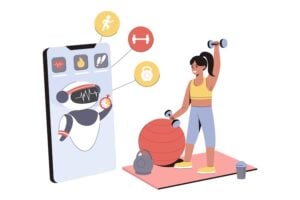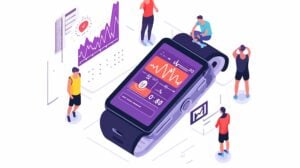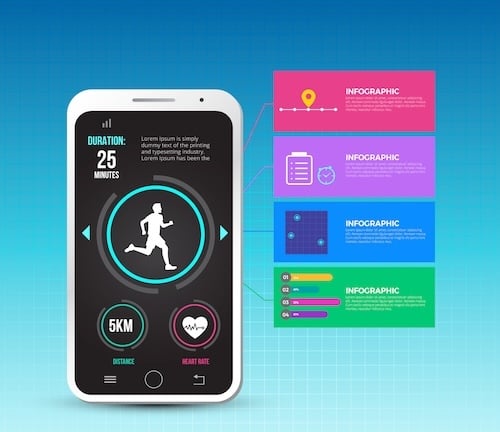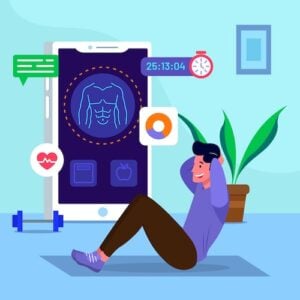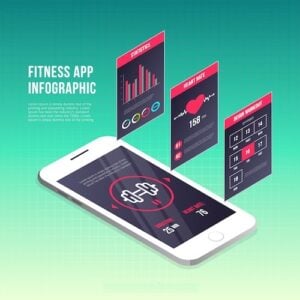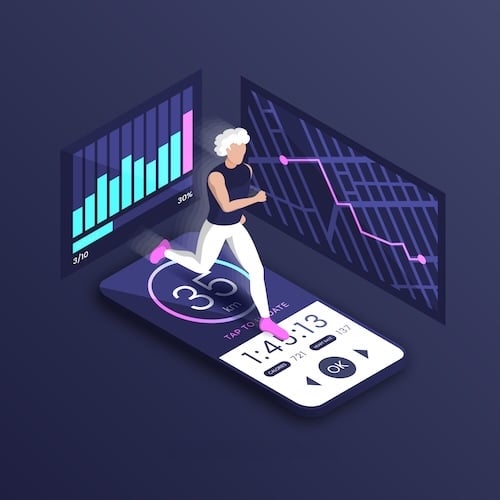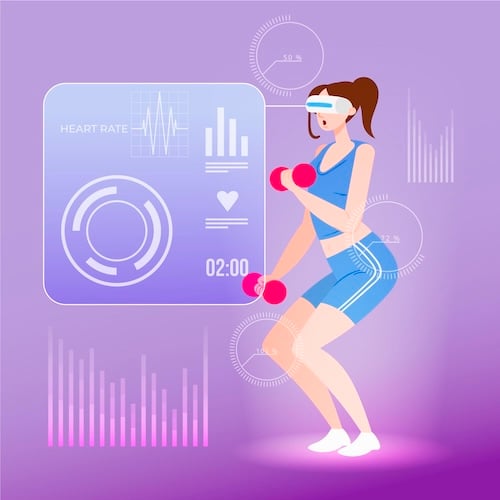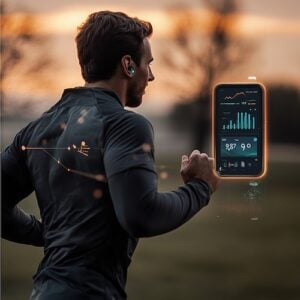When you set out to develop an AI workout app, you’re not just building another fitness tool—you’re stepping into a rapidly evolving arena where personalization is king. Users today expect more than one-size-fits-all workout plans; they crave tailored experiences that respond to their progress in real-time.
Whether you’re an entrepreneur or a tech lead, you’re likely asking: how can we create something that not only keeps users engaged but delivers measurable results? This blog explores how the smartest companies are using AI to revolutionize the fitness app space, offering actionable insights into building a product that stands out in a crowded market.
Key Takeaways:
- Customizing workouts through machine learning is key to success—when you build an AI gym app, integrating ML-driven features like real-time feedback and adaptive workout routines can drastically improve user engagement and retention.
- Efficiency in development matters—leveraging AI during the AI workout app development process itself allows you to create an MVP for as low as $60,000, saving both time and resources without sacrificing quality.
- Balancing automation with personalization is crucial—as you build an AI workout app, ensure that while AI handles routine tasks, users still have enough control to personalize their experience, ensuring satisfaction and long-term loyalty.
Table of Contents:
- AI Workout App Market Overview
- Core Features of an AI-Based Fitness App
- Steps to Develop an AI-Based Fitness App
- Challenges in AI Workout App Development
- Tech Stack for AI-Based Fitness Apps
- Cost of AI Workout App Development
- Future Trends in AI Workout Apps
- How Topflight Can Help You Build Your AI Fitness App
AI Workout App Market Overview
The surge of artificial intelligence in fitness technology has sparked a revolution, drawing fitness enthusiasts and tech entrepreneurs alike into an exciting new era. As you explore the potential to develop an AI workout app, understanding the current market landscape is essential. AI is not just a buzzword; it’s a transformative force reshaping workout routines and fitness goals across the globe.
Popular AI-Driven Workout Apps
Several notable apps have set the benchmark for AI integration in fitness:
- Fitbod: Leverages AI to craft personalized workout plans based on user feedback and performance data, ensuring that each session is uniquely tailored to individual fitness goals.
- Freeletics: Uses AI to adapt workout suggestions in real time, providing a dynamic, evolving exercise experience that matches user progression and preferences.
- Aaptiv Coach: Employs AI to combine audio-based workouts with personalized coaching, delivering a hands-free, guided exercise experience that adjusts to user feedback.
Market Statistics
The AI fitness market is booming, with growth projections painting a promising picture for the future:
- The global market for AI fitness apps is forecast to exceed $23.98 billion by 2026, reflecting a significant uptick in demand for AI-enhanced workout solutions.
- Over 60% of fitness app users report a preference for apps that offer AI-driven personalization, highlighting the value consumers place on customized fitness experiences.
- AI-integrated workout apps have seen a 30% increase in user satisfaction.
- Adoption of AI in the fitness industry is projected to grow by 30% annually.
- Investment in AI-driven fitness technologies surpassed $500 million in 2023 alone.
Key Benefits of AI Workout Apps
AI workout app development is transforming the fitness landscape by enhancing personalization and efficiency. Here are the standout benefits:
- Personalized Workout Plans: Tailor workouts to align with individual fitness goals and health status, mimicking the customized guidance of a personal trainer.
- Dynamic Adaptation: Leverage machine learning to adjust routines based on real-time user performance, keeping workouts challenging yet achievable.
- Enhanced User Experience: Boost user engagement by making fitness routines more accessible and effective, significantly contributing to health and wellness.
- Progress Tracking: Detailed insights into performance trends help users recognize improvements and set realistic goals
By harnessing AI’s potential, you can deliver a product that not only meets user expectations but also sets a new standard in the rapidly evolving fitness landscape. The journey is challenging, but the rewards—both for your business and the end-user—are immense.
Discover the essentials to build a fitness app that captures the market’s attention in our comprehensive guide.
Core Features of an AI-Based Fitness App
When looking to develop an AI-based fitness app, it’s crucial to integrate features that not only set the app apart but also deliver value and foster engagement. Here are the core features every successful AI fitness app should include.
Machine Learning-Driven Workout Suggestions
Harness the power of machine learning to provide users with dynamic and personalized workout routines. These suggestions can adapt based on user performance, preferences, and fitness goals, ensuring that workouts remain challenging and effective.
Real-Time Performance Feedback
Offer immediate insights into workout performance. By analyzing data during exercises, the application can provide corrective feedback, helping users improve form and efficiency, akin to an on-demand personal trainer.
Progress Tracking
Enable users to monitor their fitness journey with robust progress tracking. This includes logging exercises, tracking improvements, and visualizing data in user-friendly formats, which motivates users to pursue their fitness goals consistently.
Social Integration
Foster a sense of community by integrating social features. Allow users to share achievements, join group challenges, and connect with fitness communities for support and motivation.
Add-On Features
To further enhance functionality and user engagement, consider these additional features:
- Integration with Wearables: Sync with devices like smartwatches and fitness trackers to provide comprehensive health and activity data.
- Location and Movement Tracking: Utilize GPS and movement sensors to track outdoor activities such as running and cycling, offering detailed insights into distance and pace.
- Nutrition Tracking: Allow users to log meals and track nutritional intake, complementing their fitness regimes with dietary insights.
- Voice Command Functionality: Implement voice controls for hands-free operation, making the app more accessible during workouts.
- Customizable Alerts and Reminders: Help users stay on track with custom notifications for workout sessions, hydration, and rest periods.
Incorporating these features not only enhances user experience but also builds a loyal user base, ultimately driving the success of your AI workout app.
Explore the steps to build a fitness tracker app that rivals Peloton’s success by checking out our insightful blog.
Steps to Develop an AI-Based Fitness App
Embarking on the journey of developing an AI-based fitness app involves a structured approach that maximizes efficiency and innovation. Here’s a breakdown of the essential steps:
| Step | Description | Key Actions |
|---|---|---|
| Step #1: Ideation and User Research | Understand the unique needs of your target audience and shape app features accordingly. | Define app vision, conduct market analysis, and develop user personas. |
| Step #2: Prototyping and Design | Create intuitive designs and prototypes to enhance user experience and validate concepts. | Develop wireframes, focus on UX/UI, and build prototypes for early feedback. |
| Step #3: AI Integration | Enhance the app with intelligent features through AI-powered solutions. | Select AI models, collect and process data, and develop personalized algorithms. |
| Step #4: Development and Testing | Build the app incrementally while ensuring quality and performance. | Use agile methodology, conduct rigorous testing, and focus on functionality and security. |
| Step #5: Launch and Iteration | Release the app and iterate based on real-world feedback to stay competitive. | Beta test, launch on platforms, monitor analytics, and gather user feedback for continuous updates. |
Step #1: Ideation and User Research
In this foundational stage, the emphasis is on understanding the unique needs of your target users, which will shape the app’s features and functionality. Innovating in this area often involves identifying unaddressed pain points in the current market landscape.
- Define Your Vision: Begin by clarifying the app’s purpose and target audience. Understand the fitness challenges you aim to solve with AI-powered solutions.
- Conduct Market Analysis: Study existing AI-powered gym apps to identify gaps and opportunities. Gather insights on user preferences and pain points.
- User Personas: Develop detailed user personas to guide the design and functionality, ensuring the application meets diverse needs.
Step #2: Prototyping and Design
Design is where creativity meets strategy. A well-thought-out design can significantly boost user engagement by offering intuitive interfaces and seamless user journeys.
- Wireframing and UX/UI Design: Create wireframes to map out user interactions. Focus on intuitive navigation and engaging visuals that enhance user experience.
- Prototype Development: Build a prototype to validate design concepts and gather early feedback. This stage is crucial for refining the user journey.
Step #3: AI Integration
Leveraging AI is not just about adding technology but enhancing the overall user experience through intelligent and adaptive interactions.
- Select the Right AI Models: Choose machine learning models that align with your app’s goals, such as recommendation engines for personalized workouts.
- Data Collection and Processing: Implement robust data collection practices to train AI systems effectively. Ensure data quality and relevance for accurate AI outcomes.
- Algorithm Development: Develop and test algorithms that personalize workout plans and provide real-time feedback, leveraging Topflight’s expertise in AI integration.
Learn how to develop a habit tracking fitness application that keeps users motivated and engaged by visiting our detailed guide.
Step #4: Development and Testing
At Topflight, we accelerate the development process by employing out-of-the-box solutions or ready-made code for standard features. This approach allows us to concentrate our efforts on creating custom AI functionalities that differentiate your app. We also harness AI in our development practices to enhance speed and efficiency.
- Agile Development Methodology: Adopt agile practices to build the app incrementally. This allows for flexibility and continuous improvement.
- Quality Assurance: Conduct comprehensive testing, including functionality, performance, and security checks. Address any issues to ensure a seamless user experience.
Step #5: Launch and Iteration
The launch is not the end but a new beginning. Gathering user feedback and iterating based on real-world use cases keeps the app relevant and competitive.
- Beta Testing and Feedback Loop: Release a beta version to a select group of users. Use their feedback to make final adjustments.
- Official Launch: Deploy the app on relevant platforms. Monitor user engagement and gather analytics to inform future updates.
By following these structured steps and leveraging Topflight’s deep expertise in developing AI-based fitness apps, you can ensure a successful and impactful app that stands out in the competitive fitness tech landscape.
Stay ahead in the healthcare industry by understanding the impact of wearable technology in healthcare through our expert insights.
Challenges in AI Workout App Development
Building an AI workout app is a promising venture, but it comes with its own set of challenges. Addressing these hurdles effectively can be the difference between a successful app and one that falls short. Here are some of the primary challenges to navigate:
AI Model Training
Creating sophisticated AI models is a cornerstone of delivering a personalized and adaptive user experience in workout apps. On this journey, you’ll need:
- high-quality data, which must be diverse and representative of the real-world scenarios users encounter
This diversity is crucial to avoid bias and inaccuracies that can skew the model’s effectiveness.
- harnessing sufficient computational resources.
Training AI models demands significant processing power to handle large datasets and refine algorithms efficiently.
- implementation of continuous learning mechanisms, allowing the AI to evolve with new data inputs, thereby enhancing its accuracy and relevance over time.
This ongoing refinement is key to maintaining the app’s competitive edge in a dynamic market.
Find out how to create a yoga app that resonates with wellness enthusiasts by checking out our detailed blog.
Data Privacy Concerns
As AI workout apps are tasked with collecting and processing sensitive personal data, ensuring robust data privacy measures is paramount. Compliance with regulations such as GDPR or CCPA is non-negotiable, ensuring that user data is managed responsibly and ethically.
Beyond compliance and transparency, implementing stringent data security measures is essential to safeguarding user information. This includes employing strong encryption and security protocols to protect against breaches and unauthorized access.
Balancing AI Automation with User Personalization
While AI can automate many aspects of a workout app, maintaining a personalized touch is crucial for user satisfaction:
- Customization Options: Offering users the ability to customize their experience, such as adjusting workout intensity or selecting preferred trainers.
- Feedback Mechanisms: Providing channels for user feedback to refine AI recommendations and improve personalization over time.
- Human-AI Synergy: Designing the software to complement AI suggestions with human expertise, ensuring a balanced and relatable user experience.
By proactively addressing these challenges, you can build an AI workout app that not only meets but exceeds user expectations, positioning it for success in a competitive market. At Topflight, we bring our extensive experience to help you navigate these complexities, ensuring that your AI app development journey is smooth and rewarding.
Uncover the secrets to create a diet app that stands out in the crowded market by reading our actionable guide.
Tech Stack for AI-Based Fitness Apps
Building a scalable AI-driven fitness app requires a carefully selected tech stack that can support complex functionalities and deliver a seamless user experience. Here’s a guide to the essential components:
AI and ML Frameworks
Choosing the right AI and ML frameworks is crucial for developing robust and efficient AI models. Here are some top contenders:
- TensorFlow
- PyTorch
- Scikit-learn
- ChatGPT
Cloud Services
Utilizing cloud services can significantly enhance the scalability and performance of your AI gym app. Consider these options:
- Amazon Web Services (AWS)
- Microsoft Azure
- Google Cloud Platform (GCP)
Backend Technologies
A solid backend architecture is essential for handling data flow and ensuring smooth app operations. Here are some recommended technologies:
- Node.js
- Django
Frontend Technologies
The frontend of your app is what users interact with, making its choice critical for user engagement and experience. Consider the following options:
- React Native
- Flutter
- Swift/Kotlin
Integration and Expertise
Integrating these technologies seamlessly into your app’s architecture requires expertise and strategic planning. At Topflight, we leverage our deep understanding of AI and cloud technologies to create fitness apps that are not only functional but also scalable and future-proof. This approach ensures that your app can evolve with technological advancements and user demands.
By selecting the right tech stack and working with experienced professionals, you can build an AI gym app that not only meets current user expectations but is also poised to adapt to future trends and innovations.
Delve into the innovative world of move to earn app development and discover how you can create rewarding experiences for users by exploring our blog.
Cost of AI Workout App Development
When it comes to building a successful AI-powered fitness app, understanding the cost factors is essential to budget effectively and ensure a return on investment.
Topflight’s strategic approach integrates AI into the development process itself, allowing us to streamline operations and cut costs effectively. By automating routine tasks and optimizing workflows, we can deliver a Minimum Viable Product (MVP) for approximately $60,000. This includes a robust set of features that are essential for entering the market and attracting initial users.
This approach not only accelerates development cycles but also strategically allocates resources to maximize value, ensuring your investment in a successful AI-powered fitness app is both efficient and impactful.
Get to the heart of app development with our heart app development guide, perfect for those looking to make a significant impact in health tech.
Future Trends in AI Workout Apps
The fitness industry is on the cusp of a technological revolution, driven by cutting-edge AI innovations that are reshaping how we approach health and fitness. As you set out to create your own AI workout app, being aware of these emerging trends can provide a competitive edge and enhance user engagement.
AI-Enhanced Virtual Trainers
AI-powered virtual trainers are becoming increasingly sophisticated, offering users personalized coaching that rivals human trainers. These digital trainers can adapt workouts in real time based on user performance, preferences, and goals, providing a tailored fitness experience that encourages consistency and progress.
VR Integration
Virtual Reality (VR) is making waves in the fitness app domain by offering immersive workout experiences. Users can engage in virtual environments that simulate outdoor activities or competitive sports, adding an element of excitement and enhancing motivation.
Voice-Activated Fitness Assistance
With the rise of smart speakers and voice assistants, voice-activated fitness apps are gaining popularity. These apps allow users to control workouts hands-free, access real-time feedback, and receive instant answers to fitness-related questions.
Wearable Technology Integration
AI workout apps are increasingly relying on wearable app development to offer a holistic fitness experience. By syncing with smartwatches or fitness trackers, apps can provide users with comprehensive insights into their health metrics, from heart rate and calorie burn to sleep quality.
Gamification of Workouts
Gamifying fitness routines is a trend that’s capturing user interest by turning workouts into engaging challenges. AI apps can offer rewards, leaderboard competitions, and fitness milestones to motivate users.
Predictive Analytics for Fitness Goals
Predictive analytics is becoming a game-changer in personalizing fitness journeys. By analyzing user data and identifying patterns, AI apps can predict future performance trends and suggest proactive adjustments to workout plans.
Learn how to build a calorie counter app that delivers precise and user-friendly experiences with our comprehensive guide.
How Topflight Can Help You Build Your AI Fitness App
In the rapidly evolving world of fitness technology, creating AI-powered gym apps requires more than just cutting-edge tools—it demands a partner with deep expertise and a proven track record. Topflight stands at the forefront of AI-driven fitness app development, offering services that are tailored to transform your vision into reality, while ensuring data security and maximizing ROI. Our approach is holistic, focusing on both the technical and strategic aspects of AI integration.
- AI Strategy Development: We work closely with you to craft a strategic roadmap that aligns with your business goals, ensuring that every technological decision supports your vision for growth and innovation.
- Custom AI Solutions: Our team excels in designing tailored AI solutions that cater to the specific requirements of fitness apps, from personalized workout recommendations to advanced performance analytics.
- Data Security & Compliance: We prioritize your app’s security by implementing rigorous data protection measures, ensuring compliance with industry standards and regulations.
- ROI-Driven Development: Our focus is on delivering solutions that offer a clear return on investment, enabling you to achieve substantial business growth.
At Topflight, we combine our deep expertise with a forward-thinking approach to help you transform your vision into reality. We invite you to schedule a meeting with our expert team to explore how we can assist you in creating AI-powered gym apps that stand out and drive substantial value in the competitive fitness landscape. Let’s collaborate to push the boundaries of what’s possible in fitness technology.
Frequently Asked Questions
How to ensure user data privacy and security in an AI-based fitness app?
Ensuring user data privacy and security is paramount in AI-based fitness apps. At Topflight, we implement robust encryption protocols and adhere to stringent data protection standards to safeguard user information. Our approach includes regular security audits, compliance with industry regulations like GDPR, and employing secure authentication methods to prevent unauthorized access.
How do AI workout apps provide real-time feedback?
AI workout apps utilize advanced algorithms and sensor data to analyze user performance instantly. By integrating machine learning and real-time data processing, these apps can offer immediate feedback on workout form, intensity, and progress. This dynamic interaction helps users adjust their routines on the fly, maximizing the effectiveness of each session.
What are the future trends of AI fitness app development?
The future of AI fitness app development is shaped by several exciting trends. Key advancements include AI-enhanced virtual trainers, immersive VR experiences, voice-activated assistance, and predictive analytics for personalized fitness plans. These innovations aim to elevate user engagement and tailor workouts to individual needs, paving the way for more intuitive and effective fitness solutions.
How to monetize an AI-based fitness app effectively?
Monetizing an AI-based fitness app can be achieved through various strategies such as subscription models, premium features, in-app purchases, and partnerships with fitness brands. Additionally, leveraging AI to create highly personalized user experiences can increase user retention and willingness to pay for enhanced services, thus boosting revenue.
How long does it take to develop a fitness app with AI integration?
The development timeline for a fitness app with AI integration varies based on the complexity of features and the level of customization required. Typically, the process spans from 6 to 12 months, encompassing stages such as ideation, design, development, testing, and deployment. At Topflight, we streamline this process by leveraging our expertise in AI technology to ensure efficient and timely delivery.

